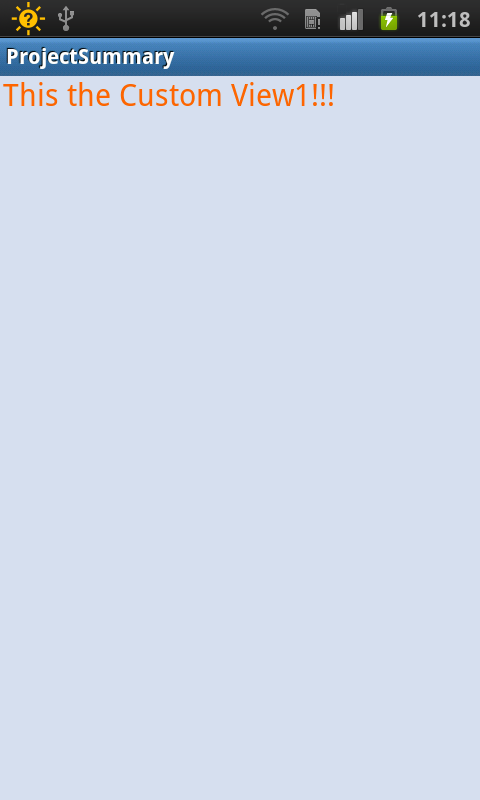转载请注明出处http://www.cnblogs.com/crashmaker/p/3530213.htmlFrom crash_coder linguowulinguowu0622@gamil.com
前言:上一篇中()介绍了Android开发中,当系统提供的控件不满足开发者需求的时候,演示如何自定义View,本文将作为上篇的延续,先大体上介绍Android是如何画出界面的,属于前提理论基础,下一篇将重点介绍Android画界面过程中的几个重要方法,如:
1,onMeasure()2,onLayout()3,onDraw()
Android绘图的理论基础:
1,我们创建一个Activity来测试上一篇中自定义的View:
a)
CustomViewActivity.java
1 public class CustomViewActivity extends Activity{2 3 @Override4 protected void onCreate(Bundle savedInstanceState) {5 // TODO Auto-generated method stub6 super.onCreate(savedInstanceState);7 setContentView(R.layout.customview_layout);8 }9 } b)
customview_layout.xml
1 28 9 16 17
c)运行结果:

2,Android是如何实现上图的效果的呢?
a)
查看google文档,它给出了如下解释:
When an Activity receives focus, it will be requested to draw its layout. The Android framework will handle the procedure for drawing, but the Activity must provide the root node of its layout hierarchy.
结合上面的例子来说明一下:当进入CustomViewActivity这个Activity时,该Activity获得焦点,此时,该Activity就会向系统请求绘制出它的布局,这个请求通过Android framework来处理,前提是:CustomViewActivity必须提供该布局的根结点,从CustomViewActivity.java看出,该Activity提供了R.layout.customview_layout,而该布局的根结点就是我们布局文件的LinearLayout;
b)
Drawing begins with the root node of the layout. It is requested to measure and draw the layout tree. Drawing is handled by walking the tree and rendering each View that intersects the invalid region. In turn, each ViewGroup is responsible for requesting each of its children to be drawn (with the draw() method) and each View is responsible for drawing itself. Because the tree is traversed in-order, this means that parents will be drawn before (i.e., behind) their children, with siblings drawn in the order they appear in the tree.
从该段文档可以了解到,Android中View的绘制是从布局的根结点开始,开始之前需要遍历整个布局结构,如果是ViewGroup,ViewGroup(如:LinearLayout,RelativeLayout等)需要对它的所有子View进行遍历及绘制,如果只是普通的View(TextView等),那么它只负责对自身进行绘制。
c)
Drawing the layout is a two pass process: a measure pass and a layout pass. The measuring pass is implemented in measure(int, int) and is a top-down traversal of the View tree. Each View pushes dimension specifications down the tree during the recursion. At the end of the measure pass, every View has stored its measurements. The second pass happens in layout(int, int, int, int)and is also top-down. During this pass each parent is responsible for positioning all of its children using the sizes computed in the measure pass.
绘制需要两个过程,一个是measure(测量大小的)过程,一个是layout(计算绘制位置的)过程:
1)measure过程:需要在measure()方法中实现,并且是自顶向下地遍历测量View的树形结构,测量完后,各结点将它的测量规格(specifications)存放在该树形结构中;
2)layout过程:通过调用layout(int,int,int,int)方法,每一个父View负责子View的绘制位置,而子View的最终大小,则是通过measure过程计算出来的大小。
d)
When a View object's measure() method returns, its getMeasuredWidth() and getMeasuredHeight() values must be set, along with those for all of that View object's descendants. A View object's measured width and measured height values must respect the constraints imposed by the View object's parents. This guarantees that at the end of the measure pass, all parents accept all of their children's measurements. A parent View may call measure() more than once on its children. For example, the parent may measure each child once with unspecified dimensions to find out how big they want to be, then call measure() on them again with actual numbers if the sum of all the children's unconstrained sizes is too big or too small (that is, if the children don't agree among themselves as to how much space they each get, the parent will intervene and set the rules on the second pass).
当每个View对象的measure()方法返回时,每个View的测量宽度值跟测量高度值必须已经被设置,且这两个值是与该View对象的父View相互作用下得来的,并不是说每个View对象都能请求到它任意想得到的值,如果这个View对象请求的宽度或者高度不合理,那么,这个View对象的父View,将再次调用measure()方法,再次确定这个View对象的最终宽度和高度,这个将在后面的onMeasure()过程详细说明中解释;
e)
The measure pass uses two classes to communicate dimensions. The ViewGroup.LayoutParams class is used by View objects to tell their parents how they want to be measured and positioned. The base ViewGroup.LayoutParams class just describes how big the View wants to be for both width and height. For each dimension, it can specify one of:1)an exact number: 2)MATCH_PARENT: which means the View wants to be as big as its parent (minus padding)3)WRAP_CONTENT: which means that the View wants to be just big enough to enclose its content (plus padding).There are subclasses of ViewGroup.LayoutParams for different subclasses of ViewGroup. For example, RelativeLayout has its own subclass of ViewGroup.LayoutParams, which includes the ability to center child View objects horizontally and vertically.MeasureSpec objects are used to push requirements down the tree from parent to child. A MeasureSpec can be in one of three modes:UNSPECIFIED: This is used by a parent to determine the desired dimension of a child View. For example, a LinearLayout may call measure() on its child with the height set to UNSPECIFIED and a width of EXACTLY 240 to find out how tall the child View wants to be given a width of 240 pixels.EXACTLY: This is used by the parent to impose an exact size on the child. The child must use this size, and guarantee that all of its descendants will fit within this size.AT MOST: This is used by the parent to impose a maximum size on the child. The child must guarantee that it and all of its descendants will fit within this size.
测量过程使用两个类与dimensions(尺寸)进行通讯,这两个类分别是ViewGroup.LayoutParams和MeasureSpec
ViewGroup.LayoutParams:
用来让View对象告诉他的父View,它需要如何被测量和放置在什么位置,然而,ViewGroup.LayoutParams只是单方面地描述它自己想要多大的宽度和高度而已,并不是最终绘制出来的宽度和高度,ViewGroup.LayoutParams可以指定为以下的值:
1)an exact number: 具体的数值;2)MATCH_PARENT: 与父容器一样的大小;3)WRAP_CONTENT: 本身该多大就多大,根据该View的内容而定,如TextView中,如果将其宽度设置为wrap_content,那么,它将随着text的长度而改变它的宽度。
MeasureSpec:
该对象封装了父容器传递给子元素的布局要求,它有三种模式:
1) UNSPECIFIED:父容器对子元素没有要求,子元素可以得到任意值; 2)
EXACTLY:父窗口决定子元素的大小,子元素将被限定在给定的边界里而忽略它本身大小; 3)
AT MOST:子元素至多达到父窗口指定的大小,子元素不能超过这个边界;